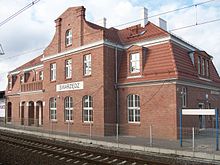Swarzędz
Swarzędz | ||
|---|---|---|
 Town Hall in Swarzędz | ||
|
Car plates PZ | | |
| Climate | Cfb | |
| Website | http://www.swarzedz.pl | |
Swarzędz [ˈsfaʐɛnt͡s] (German: Schwersenz) is a town in west-central Poland with 29,766 inhabitants. It is the seat of a mixed urban-rural commune called Gmina Swarzędz with 40,166 inhabitants. The town is situated in the Poznań metropolitan area, in the Greater Poland Voivodeship (since 1999), having previously been in Poznań Voivodeship (1975–1998).
General
The town lies directly on the route E92 and includes an aerosport facility run by the Poznań flying club, Wanda Modlibiowska. There are various companies based in the town, in particular carpentry and upholstering businesses. In addition a bicycle path from Poznań runs through the Dębiniec nature reserve and finally through the town to Pobiedziska.
History
The etymology of Swarzędz is often taken as a proof for the area's importance in the pre-Christian cult of Svarog.
The documentary evidence for a settlement on the site of modern-day Swarzędz comes from 1366. In 1377 there is mention of a rectory in the settlement.
Due to its advantageous location on the route from

In 1793 during the
Poland regained independence after
During
In 1988 Swarzędz was awarded with the Commander's Cross of the Order of Polonia Restituta, one of Poland's highest state orders.[9]
Places of interest
- There is an open-air museum (the Professor Ryszard Kostecki museum) relating to beekeeping across Europe, one of the branches of the National Museum of Agriculture in Szreniawa.
- In the neighbouring town of Uzarzewo there is a park from the 19th century with a farmstead constructed between 1860 and 1865. There is a Hunting Museum there.
- In the village of Wierzenica there is a wooden church, St. Nikolaus, dating from the second half of the 16th century. At the church is the grave of August Cieszkowski (1814–1894). Near the village there is a graveyard with graves dating back to the Bronze Age.
- The church of St. Martin in Swarzędz (18th century).
- Church of the Archangel Michael in Uzarzewo.
Transport

There is a railway station in Swarzędz. The town has railway connections with major Polish cities such as Poznań, Warsaw, Łódź and Szczecin.
Sports

The local football club is Unia Swarzędz. It competes in the lower leagues.
Notable residents
- Aleksander Doba (born 1946), Polish kayaker, 2014 Adventurer of the Year
- Andrzej Fischer (1952–2018), Polish footballer
- Erich Ludendorff(1865–1937), German general
- Paulina Wilkońska (1815–1875), Polish novelist
- Philipp Jaffé (1819–1870), German historian
- Robert Siewert (1887–1973), German politician
- Siegfried Placzek (1866–1946), American neurologist and psychiatrist
- Simon Baruch (1840–1921), American physician
- Zenon Baranowski (1930–1980), Polish Olympic athlete
- Antoni Tabaka (1881–1945), Polish industrialist
References
- ^ Arkadiusz Małyszka, Zmiana granic Swarzędza w czasach sprawowania urzędu burmistrza przez Tadeusza Staniewskiego (1934 rok), "Tadeusz Staniewski 1873–1940", Swarzędz, 2010, p. 25 (in Polish)
- ^ Aurelia Szafran-Bartoszek, Biografia Tadeusza Staniewskiego, "Tadeusz Staniewski 1873–1940", Swarzędz, 2010, p. 10 (in Polish)
- ^ a b c Uchwała nr XIX/203/2016 Rady Miejskiej w Swarzędzu z dnia 23 lutego 2016 r. w sprawie: nadania nazwy ulicy na terenie miasta Swarzędz (in Polish)
- ^ a b Szafran-Bartoszek, p. 11
- ^ Małyszka, p. 31-32
- ^ Maria Wardzyńska, Wysiedlenia ludności polskiej z okupowanych ziem polskich włączonych do III Rzeszy w latach 1939-1945, IPN, Warszawa, 2017, p. 151, 192 (in Polish)
- ^ Szafran-Bartoszek, p. 15
- ^ Szafran-Bartoszek, p. 15-16
- ^ Uchwała Rady Państwa z dnia 29 czerwca 1988 r. w sprawie nadania orderów społecznym zbiorowościom., Dz. U. z 1988 r. Nr 21, poz. 190
External links
- Official website
- Much of the information contained in this article was translated from the German version

